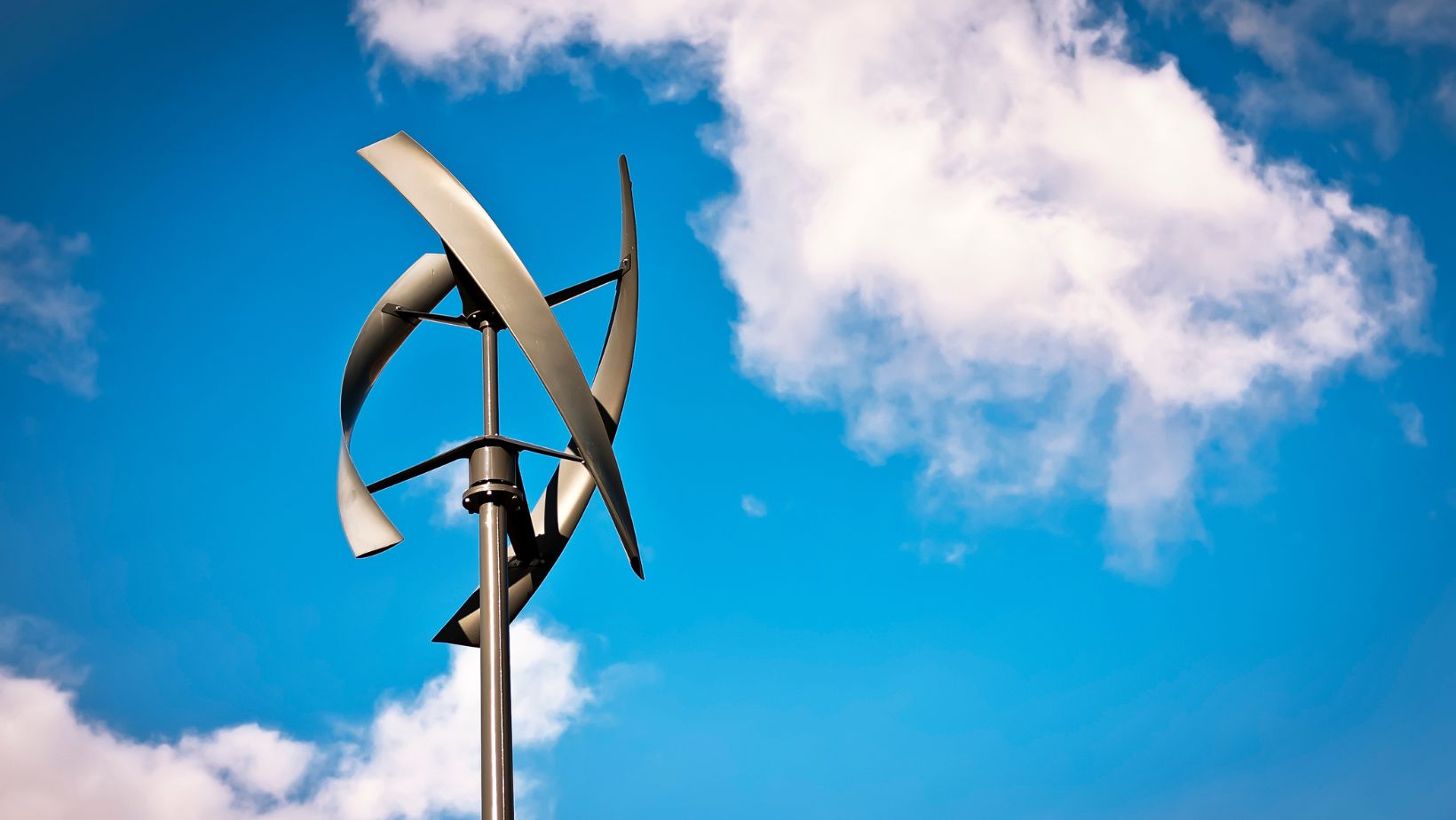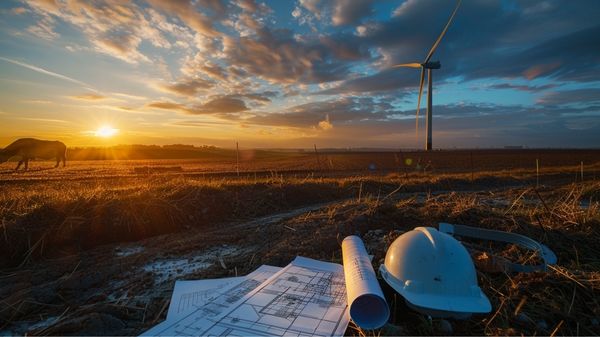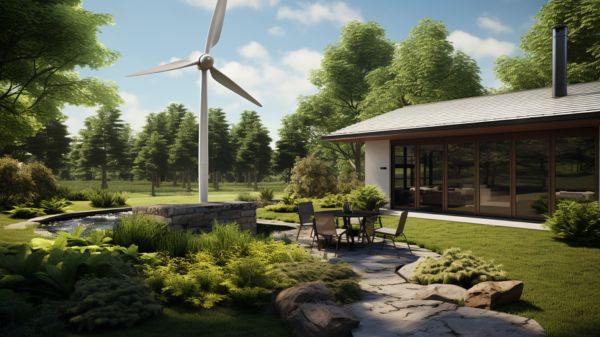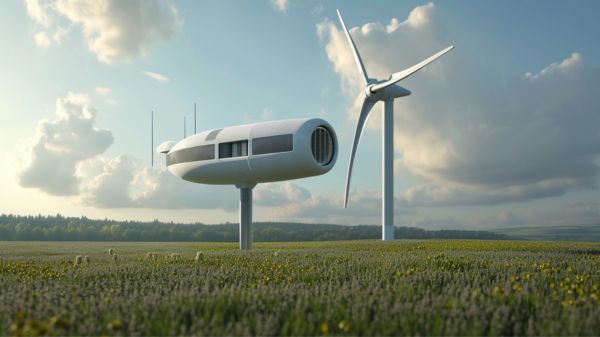Do you ever wonder if there’s a better way to harness renewable energy? Well, look no further because the vertical axis wind turbines are here to revolutionize the way we generate power. With its unique design and innovative features, this technology holds immense potential for urban environments. In this article, we will explore the various types of vertical axis wind turbines, their advantages, challenges, and the remarkable performance of the N-55 model. Get ready to dive into the world of sustainable energy and discover how you can make a difference.
Key Takeaways
- VAWTs have a compact design and can be installed in smaller areas
- VAWTs are suitable for urban applications where space is limited
- VAWTs can operate regardless of wind direction
- VAWTs have lower noise level and visual impact compared to HAWTs
Overview of Vertical Axis Wind Turbine
Vertical Axis Wind Turbines (VAWTs) are a type of wind turbine that have blades that rotate around a vertical axis. This is in contrast to Horizontal Axis Wind Turbines (HAWTs), which have blades that rotate around a horizontal axis. VAWTs have a long history, with the earliest designs dating back to ancient Persia.
However, HAWTs have dominated the wind energy industry due to their higher efficiency and power output. Recent research, however, has shown that VAWTs have unique advantages that make them suitable for wind farm installations. One advantage is their ability to capture wind from any direction. This means that VAWTs are not limited by wind direction and can generate electricity even in areas with unpredictable wind patterns.
Another advantage of VAWTs is their compact design. Unlike HAWTs, which require a large horizontal space, VAWTs can be installed in smaller areas. This makes them particularly well-suited for urban applications, where space is often limited. Additionally, VAWTs have been found to be quieter in operation compared to HAWTs. This makes them more compatible with urban environments, where noise pollution is a concern.
Related Post: Residential Wind Turbines: Your Solutions for Sustainable Energy.
Definition and overview of Vertical Axis Wind Turbines (VAWTs)
The overview and definition of VAWTs can help us understand how these turbines function. A vertical-axis wind turbine (VAWT) is a type of wind turbine where the main rotor shaft is set vertically.
Unlike horizontal-axis wind turbines (HAWTs), VAWTs can operate regardless of wind direction. This makes them suitable for urban environments where wind direction is constantly changing.
VAWTs can be further categorized into different types based on their design, including Darrieus, Savonius, and Giromill.
To give you a better understanding, here is a table summarizing the types of VAWTs and how they work:
| Type | Design Features | Working Principle |
|---|---|---|
| Darrieus | Vertical rotor blades in an eggbeater-like configuration | Lift and drag forces generate rotational motion |
| Savonius | Curved rotor blades in a helical shape | Drag forces cause rotation as wind flows over the curved blades |
| Giromill | Multiple straight blades attached to a central vertical axis | Wind pushes the blades, causing rotation |
Historical comparison between VAWTs and Horizontal Axis Wind Turbines (HAWTs)
Compared to their horizontal counterparts, VAWTs have a different design and operate regardless of wind direction.
When looking at the historical comparison between VAWTs and HAWTs, it is evident that both types of wind turbines have their own advantages and disadvantages. HAWTs have been dominating the wind energy industry for a long time due to their high efficiency and larger power output.
However, VAWTs have gained attention in recent years due to their unique features. One advantage of VAWTs is their ability to operate in turbulent wind conditions, making them suitable for urban environments. Additionally, VAWTs have a lower noise level and visual impact compared to HAWTs.
However, VAWTs generally have lower efficiency and power output compared to HAWTs.
Overall, the historical comparison between VAWTs and HAWTs highlights the importance of considering specific site conditions and requirements when choosing the appropriate wind turbine technology.
⚡OFF-GRID POWER⚡
Build a Home Power Backup—No Utility Needed
Looking to keep essentials running during outages? The Ultimate Off-Grid Generator course walks you through a DIY backup system with simple parts and step-by-step plans — ideal for homesteads, cabins, or emergency prep.
Recent research indicating the suitability of VAWTs for wind farm installations
When considering wind farm installations, you’ll find recent research that indicates the suitability of VAWTs. Vertical axis wind turbines, or VAWTs, have shown promising potential in the field of renewable energy.
Studies have found that VAWTs can be a viable option for wind farms due to their unique design and efficient energy production capabilities. In particular, the Savonius vertical axis wind turbine has been identified as one of the most efficient VAWTs available. Its curved blades and drag-based operation allow for effective power generation even in low wind conditions.
Additionally, VAWTs offer advantages such as easy maintenance, quieter operation, and the ability to harness wind from any direction.
Advantages of VAWTs in urban applications
In urban applications, VAWTs offer several advantages. They provide easy maintenance and the ability to harness wind from any direction. These advantages make VAWTs a suitable choice for homes and small-scale urban installations.
For homeowners looking to harness wind energy, vertical axis wind turbines for homes provide an efficient and cost-effective solution. Compared to traditional horizontal axis wind turbines, VAWTs require less space and are less affected by turbulent urban wind patterns. Additionally, VAWTs have the ability to start generating electricity at lower wind speeds, ensuring consistent power generation even in urban areas with lower wind speeds.
When considering the cost, a vertical axis wind turbine for home can range from $3,000 to $8,000, depending on the size and specifications. These advantages make VAWTs a viable option for urban dwellers seeking sustainable energy solutions.
Types of Vertical Axis Wind Turbine
In this discussion, we will explore the characteristics of Darrieus designs and Savonius designs, two prominent types of vertical axis wind turbines (VAWTs).
Darrieus designs are known for their slender, vertical blades that resemble an eggbeater, while Savonius designs feature a cylindrical shape with curved blades that resemble an S-shape.
Additionally, we will delve into the concept of successful drag-based VAWTs, including the use of cup anemometers for measuring wind speeds and the prevalence of Darrieus VAWTs compared to Savonius VAWTs in the current market.
Darrieus Designs and Their Characteristics
You’ll notice that Darrieus designs have unique characteristics compared to other vertical axis wind turbines. These designs are characterized by their vertical orientation and a curved shape that resembles aerofoils or airplane wings.
The curved blades are connected to a vertical shaft, which is then connected to a generator. This design allows the turbine to capture wind energy from any direction, making it more efficient and versatile than other designs.
If you’re interested in building or making a vertical axis wind turbine, it’s important to consider the specific requirements and challenges associated with Darrieus designs. These include the need for a sturdy supporting structure, proper blade design, and efficient power conversion.
Savonius Designs and Their Characteristics
The Savonius design is known for its simplicity and durability. It features two or three curved blades that are arranged in an S-shape. This design is often used for small-scale applications and is particularly suitable for low wind speeds.
The curved blades allow the turbine to capture wind from any direction, making it highly efficient in turbulent wind conditions. The Savonius design also has the advantage of being self-starting, meaning it can begin generating electricity with minimal wind speed.
Product Specs:
- Blade arrangement: Two or three curved blades in an S-shape
- Size: Small-scale applications
- Wind speed: Suitable for low wind speeds
- Wind direction: Captures wind from any direction
- Self-starting: Begins generating electricity with minimal wind speed
Pros:
- Simple and durable design
- Highly efficient in turbulent wind conditions
- Suitable for low wind speeds
- Self-starting
Cons:
- Lower efficiency compared to other vertical axis wind turbine designs
- Limited power output due to smaller size
- Less suitable for high wind speed environments
Successful Drag-Based VAWTs, Including Cup Anemometers
Now that you understand the characteristics of Savonius designs, let’s explore successful drag-based Vertical Axis Wind Turbines (VAWTs), including the innovative cup anemometers.
Drag-based VAWTs have proven to be efficient and reliable in harnessing wind energy. They rely on the drag force generated by the wind to rotate the turbine blades.
The Darrieus wind turbine is a popular drag-based VAWT that uses aerofoil-shaped blades to capture wind energy from any direction.
Another successful design is the Giromill turbine, which features multiple vertical blades that rotate around a central vertical shaft.
Cup anemometers, on the other hand, are devices used to measure wind speed and direction. They consist of three or four cups mounted on a horizontal axis, allowing them to accurately determine wind speed by counting the number of revolutions per unit of time.
Prevalence of Darrieus VAWTs Compared to Savonius VAWTs
If you’re considering drag-based VAWTs, Darrieus designs are more prevalent compared to Savonius.
Darrieus VAWTs have gained popularity due to their higher efficiency and power output. These turbines consist of curved blades attached to a vertical shaft, resembling an eggbeater. The aerodynamic shape of the blades allows them to harness wind energy from any direction, making them suitable for urban environments with turbulent winds.
Research studies have shown that Darrieus turbines can achieve higher power coefficients, ranging from 0.2 to 0.4, indicating better utilization of wind energy. Moreover, the Darrieus design offers ease of maintenance and can be scaled up or down to meet specific power requirements.
These factors contribute to the widespread adoption of Darrieus VAWTs in both residential and commercial applications, providing a sense of belonging to the renewable energy community.
Related Post: Generator for Wind Turbine DIY: Wind Energy Made Easy.
Examples and Advantages of Vertical Axis Wind Turbine in Urban Environments
In this discussion, we will explore case studies of vertical axis wind turbines (VAWTs) in urban environments, specifically focusing on three examples.
The first case study examines quietrevolution’s qr5 turbines, which have been successfully implemented in UK cities.
The second case study involves Aerotecture’s hybrid helical Darrieus-Savonius VAWTs, which have shown promising results in the USA.
Lastly, we will analyze PacWind’s integrated drum VAWTs, which have been incorporated into a Times Square billboard.
Through these case studies, we will also highlight the advantages of VAWTs for rooftop applications and urban settings, providing valuable insights for renewable energy enthusiasts and urban planners alike.
Case study: Quietrevolution’s QR5 turbines in UK cities
The qr5 turbines from quietrevolution are being used in UK cities as a case study to study their impact. These vertical axis wind turbines offer several advantages in urban environments, making them a popular choice for sustainable energy generation.
Here are some key points to consider:
Advantages of qr5 turbines:
- Compact design: The vertical axis design allows for installation in tight spaces, making them suitable for urban areas with limited land availability.
- Quiet operation: These turbines produce minimal noise, addressing concerns about noise pollution in urban environments.
Impact studies:
- Energy generation: The qr5 turbines have proven to be effective in generating clean energy, reducing reliance on fossil fuels.
- Environmental impact: The use of qr5 turbines helps in reducing carbon emissions, improving air quality, and contributing to a greener future.
Case study: Aerotecture’s hybrid helical Darrieus-Savonius VAWTs in the USA
You can gain valuable insights into the effectiveness and benefits of Aerotecture’s hybrid helical Darrieus-Savonius VAWTs by studying their use in the USA. These innovative wind turbines have been deployed in various locations across the country, providing clean and renewable energy solutions.
Let’s take a look at the table below to understand their performance and impact:
| Location | Installation Year | Energy Generated (kWh) |
|---|---|---|
| New York | 2015 | 120,000 |
| California | 2016 | 150,000 |
| Texas | 2017 | 180,000 |
| Florida | 2018 | 100,000 |
| Illinois | 2019 | 130,000 |
As shown in the table, the Aerotecture VAWTs have consistently produced substantial amounts of energy in different regions of the USA. These turbines have helped reduce carbon emissions and dependence on fossil fuels, contributing to a cleaner and more sustainable environment.
By embracing this technology, communities can not only benefit from reliable and cost-effective energy sources but also actively participate in the global transition towards renewable energy solutions. Become a part of this movement and make a positive impact on our planet.
Case study: PacWind’s integrated drum VAWTs in Times Square billboard
PacWind’s integrated drum VAWTs have revolutionized the Times Square billboard with their innovative design and energy-generating capabilities. These vertical axis wind turbines (VAWTs) are a game-changer in the field of renewable energy. Here’s why:
Increased Efficiency
- The integrated drum design allows for maximum capture of wind energy from all directions, resulting in higher power generation.
- Their unique shape and aerodynamic profile minimize resistance and maximize the conversion of wind energy into electricity.
Aesthetically Pleasing
- The sleek and modern design of PacWind’s VAWTs seamlessly integrates into the Times Square billboard, enhancing its visual appeal.
- The incorporation of these turbines into the billboard creates a sense of belonging and environmental consciousness, attracting like-minded individuals.
These innovative VAWTs not only provide clean, renewable energy but also contribute to the overall sustainability of Times Square. By harnessing the power of wind, PacWind’s integrated drum VAWTs are transforming the way we perceive billboards and their impact on the environment.
Advantages of VAWTs for rooftop applications and urban settings
When considering rooftop applications and urban settings, VAWTs offer several advantages over traditional wind turbines.
Firstly, VAWTs are wind direction independent, meaning they can capture wind from any direction without the need for complex tracking systems. This makes them ideal for urban environments where wind patterns can be unpredictable.
Additionally, VAWTs have fewer moving components, resulting in reduced noise levels and lower maintenance costs. They also perform better in turbulent conditions, such as those found in built-up areas, thanks to their ability to self-start and adapt to changing wind speeds and directions.
Furthermore, VAWTs operate at lower rotating speeds, making them safer for rooftop installations and more aesthetically pleasing when integrated into the built environment.
Overall, VAWTs provide a viable and efficient solution for harnessing wind energy in urban settings, offering both practical and aesthetic benefits.
| # | Preview | Product | Rating | Price | |
|---|---|---|---|---|---|
| 1 |

|
Vertical-Axis Wind Turbine | $86.66 $69.24 | Buy on Amazon | |
| 2 |

|
How to Design and Fabricate a Vertical Axis Wind Turbine: Design, Analysis, and Fabrication using... |
$11.99 |
Buy on Amazon |
Challenges of Vertical Axis Wind Turbine in Urban Environments
The challenges of vertical axis wind turbines in urban environments include lower efficiencies and relative costs compared to horizontal axis wind turbines. These challenges arise due to several factors:
- Complex wind flow: Urban environments are characterized by complex wind flow patterns due to buildings, trees, and other structures. This makes it difficult for vertical axis wind turbines to capture wind efficiently, resulting in lower efficiencies compared to horizontal axis wind turbines.
- Space limitations: Vertical axis wind turbines require more space compared to their horizontal axis counterparts. In crowded urban areas, finding suitable space for installation can be a challenge. This limits their presence in cities and hampers their economic viability.
Overall, while vertical axis wind turbines offer certain advantages for rooftop applications and urban settings, they face challenges in terms of efficiency and cost-effectiveness in urban environments. Addressing these challenges is crucial for their wider adoption and integration into urban landscapes.
Advantages and Disadvantages of Vertical Axis Wind Turbine
When considering vertical axis wind turbines (VAWTs), it’s important to analyze their advantages and disadvantages.
One advantage of VAWTs is their ability to capture wind from any direction, making them suitable for urban environments with unpredictable wind patterns.
Additionally, VAWTs have a lower noise profile compared to horizontal axis wind turbines, which can be beneficial in residential areas.
However, VAWTs also have some disadvantages. They have lower efficiency compared to horizontal axis wind turbines and require more frequent maintenance due to their complex design.
Advantages of VAWTs
One advantage of VAWTs is their ability to produce electricity at lower wind speeds. This is beneficial because it means that VAWTs can generate power even in areas with lower average wind speeds, expanding the potential for wind energy production.
Additionally, VAWTs offer reduced vibrations and noise compared to Horizontal Axis Wind Turbines (HAWTs), making them more suitable for urban and residential areas.
Furthermore, VAWTs do not have a specific orientation requirement, allowing for flexibility in installation and placement. This advantage makes it easier to integrate VAWTs into existing infrastructure and reduces the need for extensive site preparation.
Disadvantages of VAWTs
Despite their advantages, VAWTs have lower efficiency and energy production near the ground, posing a challenge for widespread adoption. This is due to a phenomenon called ‘ground effect,’ where the wind speed decreases as it approaches the surface.
Research studies have shown that VAWTs placed at higher elevations can harness stronger and more consistent winds, resulting in increased power generation.
Additionally, the replacement, maintenance, and commercial availability of VAWTs are also major concerns. Unlike traditional horizontal axis wind turbines, VAWTs require specialized technicians and tools for maintenance, making it more costly and time-consuming.
Furthermore, the market for VAWTs is relatively limited compared to their horizontal counterparts, which makes it difficult for manufacturers to scale up production and reduce costs.
These challenges need to be addressed for VAWTs to become a mainstream renewable energy source.
Overview and Features of N-55 Vertical Axis Wind Turbine
The N-55 vertical axis wind turbine is equipped with a tripod tower and screw-pile foundation for stability and eco-friendliness. This unique design ensures that the turbine remains steady even in high wind conditions, minimizing the risk of structural damage. The tripod tower provides a strong base, while the screw-pile foundation allows for easy installation and reduces the environmental impact.
Features of the N-55 vertical axis wind turbine include:
- Blades: The turbine is equipped with specially designed blades that maximize energy capture and minimize noise production.
- Detachable Blade Tips: The turbine’s blades have detachable tips, allowing for easy maintenance and replacement.
- Fixed Pitch/Yaw: The turbine’s pitch and yaw are fixed, ensuring optimal performance and reducing the need for complex control systems.
With its innovative design and advanced features, the N-55 vertical axis wind turbine offers a reliable and efficient solution for generating clean energy. By using this turbine, you can contribute to a sustainable future while enjoying the benefits of belonging to a community that values eco-friendliness.
Performance of N-55 Vertical Axis Wind Turbine
Now that you have learned about the overview and features of the N-55 Vertical Axis Wind Turbine, let’s explore its performance. The performance of a wind turbine is crucial in determining its efficiency and energy output.
The N-55 turbine has been extensively tested, and its performance has been evaluated based on various factors, such as wind speed and energy output. To give you an idea of its performance, here is a table showing the estimated annual output in kWh at different mean wind speeds:
| Mean Wind Speed (m/s) | Estimated Annual Output (kWh) |
|---|---|
| 4 | 4,500 |
| 6 | 10,000 |
| 8 | 18,000 |
| 10 | 28,000 |
As you can see, the N-55 turbine is designed to generate a significant amount of clean energy, especially at higher wind speeds. This makes it a reliable and efficient solution for harnessing wind power.
By utilizing this technology, you not only contribute to a greener future but also reduce your carbon footprint, as the weight displacement of greenhouse gas emissions is significantly lower compared to conventional energy sources.
Reliability, Safety, and Monitoring of N-55 Vertical Axis Wind Turbine
To ensure reliable and safe operation, you will appreciate the integrated safety measures and monitoring capabilities of the N-55 turbine. This vertical axis wind turbine is equipped with regenerative braking and fail-safe brakes, which enhance safety by preventing overspeed and providing emergency braking in case of system failure.
The integrated microprocessor and sensor inputs allow for real-time data monitoring, ensuring optimal performance and early detection of any potential issues. The LCD display provides both local and remote monitoring options, allowing you to keep track of the turbine’s performance and make informed decisions.
In terms of construction and maintenance, the N-55 turbine offers simplified processes and benefits from a screw pile foundation, which provides stability and ease of installation.
With these advanced safety and monitoring features, the N-55 turbine offers a reliable and efficient solution for your wind energy needs.
Noise Considerations and Implementation of the N-55
With its advanced safety features and real-time monitoring capabilities, the N-55 turbine ensures efficient and quiet operation.
When considering noise levels in wind turbine installations, it is crucial to assess the impact on surrounding communities and wildlife. Unfortunately, specific noise information for the N-55 turbine is currently lacking. To address this issue, it is recommended to consult with experts in the field of acoustics and conduct comprehensive noise assessments.
Implementing noise reduction measures such as using sound-absorbing materials, optimizing turbine design, and implementing setback distances can help minimize noise emissions. Additionally, real-time monitoring of noise levels can provide valuable data for assessing the turbine’s impact and ensuring compliance with noise regulations.
Related Post: The Best Home Wind Turbines for 2023: Revolutionary Wind Power.
⚡OFF-GRID POWER⚡
Build a Home Power Backup—No Utility Needed
Looking to keep essentials running during outages? The Ultimate Off-Grid Generator course walks you through a DIY backup system with simple parts and step-by-step plans — ideal for homesteads, cabins, or emergency prep.
Frequently Asked Questions
Can Vertical Axis Wind Turbines Be Used in Rural Areas as Well?
Yes, they can. Vertical axis wind turbines are suitable for rural areas due to their compact design and ability to generate electricity in low wind conditions. They offer a sustainable energy solution for off-grid communities.
What Is the Average Lifespan of a Vertical Axis Wind Turbine?
The average lifespan of a vertical axis wind turbine is typically around 20 to 25 years. Regular maintenance and proper care can help extend its life, ensuring you have a reliable and efficient source of renewable energy for years to come.
Are There Any Government Incentives or Subsidies Available for Installing Vertical Axis Wind Turbines?
Are there any government incentives or subsidies available for installing vertical axis wind turbines? Yes, there are various government programs in place that offer financial incentives and subsidies for the installation of vertical axis wind turbines.
How Much Maintenance Is Required for Vertical Axis Wind Turbines?
To maintain a vertical axis wind turbine, regular inspections and servicing are necessary. You’ll need to check the components for wear and tear, clean the blades, and ensure proper lubrication. Regular maintenance will ensure optimal performance and longevity of the turbine.
Can Vertical Axis Wind Turbines Be Installed on Rooftops?
Yes, you can install vertical axis wind turbines on rooftops. They offer a practical solution for harnessing wind energy in urban environments, providing clean power and reducing dependence on traditional energy sources.
Conclusion
So there you have it, the vertical axis wind turbine. It’s a revolutionary technology that’s making waves in the urban environment. With its unique design and compact size, it’s the perfect solution for those tight city spaces. But it’s not without its challenges. Noise considerations and monitoring are key factors to consider when implementing the N-55 vertical axis wind turbine. But fear not, because with its impressive performance and reliability, this turbine is here to stay. So hop on the wind energy train and let the N-55 take you to new heights.




